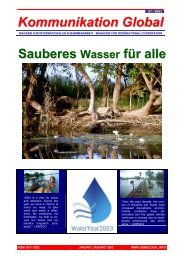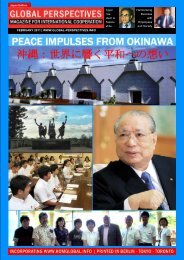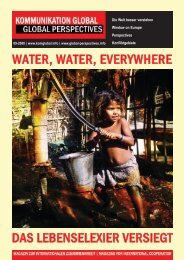GLOBAL PERSPECTIVES | KOMMUNIKATION GLOBAL - 01 | 2009
GLOBAL PERSPECTIVES | KOMMUNIKATION GLOBAL - 01 | 2009
GLOBAL PERSPECTIVES | KOMMUNIKATION GLOBAL - 01 | 2009
Create successful ePaper yourself
Turn your PDF publications into a flip-book with our unique Google optimized e-Paper software.
COVER STORY | TITELTHEMA<br />
In total, roughly 75 million dollars were spent on irrigation reconstruction in Afghanistan<br />
and another 28 million dollar investment is planned. This, however, represents only a fraction<br />
of the resources that is spent on other development efforts, the report says.<br />
Law Enforcement<br />
No law enforcement, weak protection mechanisms<br />
and a dysfunctional civil registry undermine access<br />
to and the enjoyment of economic and social rights.<br />
Under Afghanistan Constitution and ratified International<br />
human rights laws which on paper guarantee<br />
access to the social and economic rights. However,<br />
the system of law enforcement and justice remains<br />
weak and inefficient. Few legal provisions are accompanied<br />
of administrative instructions or other<br />
means for implementation, limiting the effectiveness<br />
of rights protection, prevention of violations,<br />
and law enforcement in general.<br />
Furthermore, the main government registries for<br />
issuing IDs, birth and marriage certificates, and divorce<br />
registrations are dysfunctional. At best, the<br />
system reaches provincial centers, leaving out the<br />
majority of population concentrated in rural areas.<br />
Without a functional and efficient administrative<br />
system, the government of Afghanistan will continue<br />
to struggle in understanding the needs and protecting<br />
and promoting the rights of its population.<br />
Labor Rights<br />
Labor rights remained largely unprotected due to<br />
failure of the government to develop regulations and<br />
protection mechanisms to enforce the law. In particular,<br />
this refers to the workers employed in the<br />
informal economy, child labour, labour migrants,<br />
and women.<br />
At the time of writing this report, there were no<br />
legal provisions addressing irregular and casual labour,<br />
including the lack of mechanisms to estimate<br />
numbers or to understand the needs and protect the<br />
rights of workers employed in the informal economy<br />
and relying on a daily-wage labour.<br />
Casual workers have no access to skills upgrading<br />
or avenues for collective bargaining to improve their<br />
quality of life. Child labour is prevalent; nearly a<br />
quarter of children in Kabul work despite the legal<br />
ban on any full-time labour under 18 years of age.<br />
The conditions of work are hazardous: long hours in<br />
unhealthy environments with unsafe equipment. The<br />
situation of casual workers and children make them<br />
vulnerable to trafficking and forced labour.<br />
An anti-trafficking law is being developed and two<br />
units were formed to combat trafficking in persons;<br />
their work, however, is sporadic.<br />
Of particular concern is the deportation of irregular<br />
labor migrants from Iran during the winter of<br />
2007-2008. A portion of these deportees might have<br />
been trafficked or worked in forced labor situations.<br />
Afghan irregular labour migrants in Iran are unprotected<br />
and the government of Afghanistan failed to<br />
secure their rights to due process during deportation<br />
and to protection upon their arrival in Afghanistan.<br />
Rights and protection of women in both formal and<br />
informal employment need special attention.<br />
Currently, maternity leave is the only measure<br />
implemented to protect the rights of working<br />
women. There is a need to extend their protection,<br />
in particular, with regard to sexual abuse and harassment<br />
at the workplace. As of now, there are no<br />
existing mechanisms to protect women and offer<br />
safe avenues to report incidents. There are also no<br />
incentives to attract more women into the workforce<br />
such as the provision of childcare and job<br />
training as well as gender-sensitive workforce policies.<br />
The Constitution of Afghanistan offers an excellent<br />
basis for an equitable and just society. Law enforcement,<br />
however, needs to be strengthened. The<br />
government needs to implement labor codes, particularly<br />
in regards to daily-wage workers, health<br />
care, a safe work environment, and child labor.<br />
Social Security System<br />
The social security system in Afghanistan is focused<br />
only on the provision of pensions to persons with<br />
disabilities, former government employees, and<br />
families of martyrs, and services for children. Despite<br />
constitutional provisions for support to older<br />
persons, ill or women without caretakers, no protection<br />
mechanisms were developed and the implementation<br />
of the law remains sporadic.<br />
Extremely vulnerable households that are headed<br />
by females, children, older persons, IDPs, returnees,<br />
and those who have more than eight children have<br />
no additional protection even as they have less social<br />
tools to cope. At the time of writing this report,<br />
civil society organizations and international community<br />
were the sole providers of social services to<br />
these groups; service delivery relies entirely on international<br />
donors.<br />
Situation of Women<br />
Based on the Constitution and commitments of the<br />
government, women saw little improvement in exercising<br />
their right to protection in family life. In Afghanistan,<br />
this would include a right to marry consensually<br />
without coercion, freedom from underage<br />
marriage, the right to equality between men and<br />
women during marriage and its dissolution, and protection<br />
from domestic violence.<br />
Prevalence of child marriage is a particular concern<br />
since roughly 60 percent of females in Afghanistan<br />
marry before their 16 th birthday. Forced marriage<br />
is prevalent, and couples that decide to marry<br />
without parental consent are often prosecuted and<br />
persecuted by respective family members.<br />
Despite the fact that both underage and forced<br />
marriage are illegal and punishable by up to two<br />
years in prison, not one sentence has been issued<br />
under this article of the law. Violence against<br />
women is pandemic and remains largely unpunished<br />
even when it results in murder.<br />
The pressure of repayment of debt is a potential<br />
threat to women’s rights; a number of documented<br />
cases and anecdotal evidence show that women are<br />
sometimes compelled to marry to settle debts and<br />
re-pay credits. This has particular implications for<br />
micro credit schemes and for policy makers since<br />
currently there is neither tracking mechanism nor<br />
efficient bankruptcy laws to ensure that women are<br />
not adversely affected by the credit practices of<br />
their families. IDN | <strong>GLOBAL</strong> <strong>PERSPECTIVES</strong> �<br />
<strong>GLOBAL</strong> <strong>PERSPECTIVES</strong> | JANUARY <strong>2009</strong> 19















